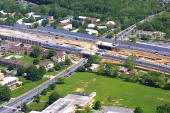 |
I-495 Capital Beltway passing over VA-617 Backlick
Road, this is just west of the Springfield Interchange construction. Looking
northwest.
Phase 5 of the SIIP involved widening the
Beltway west of I-95, relocating the
Outer Loop of the Beltway in the I-95 interchange area, and realignment of
the ramp from I-395 southbound to I-495 westbound, and widening the
Capital Beltway from I-395 westward to near VA-620 Braddock Road. Phase 5
was placed under construction in August of 2001, and was completed in May
2004 at a cost of $95.5 million.
Phases 4 and 5 of the SIIP included extensive construction
of sound barrier walls along the western, southern and eastern edges of
the interchange and approaches. Notice the sound barrier walls under
construction along the edge of the Beltway. |
 |
I-495
Capital Beltway passing over VA-617 Backlick Road, this is just west of the
Springfield Interchange construction. Looking north. Flanking roadways have
been built for the ramp highways to and from Shirley Highway, and mainline
Beltway traffic is temporarily operating there as the mainline Beltway roadways
and bridges are being demolished and reconstructed.
Shirley Highway is I-95 south of the Beltway,
and is I-395 north of the Beltway. The Capital Beltway is I-495 throughout,
and carries I-95 also east of Shirley Highway.
|
 |
I-495
Capital Beltway passing over VA-617 Backlick Road, this is just west of the
Springfield Interchange construction. Looking eastward toward Shirley Highway.
Flanking roadways have been built for the ramp
highways to and from Shirley Highway, and mainline Beltway traffic is temporarily
operating there as the mainline Beltway roadways and bridges are being demolished
and reconstructed.
Notice the sound barrier walls under
construction along the edge of the interchange. |
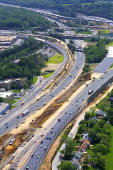 |
I-495
Capital Beltway, looking east from over VA-617 Backlick Road, eastward
toward Shirley Highway and the I-95/I-395/I-495 interchange.
Flanking roadways have been built for the ramp
highways to and from Shirley Highway, and mainline Beltway traffic is temporarily
operating there as the mainline Beltway roadways and bridges are being demolished
and reconstructed. |
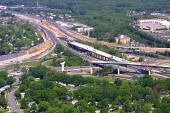 |
I-95/I-395/I-495
interchange construction, looking northwest. The elevated ramp under construction
in the foreground is the B-610 bridge that will be the 2-lane express
flyover ramp (the I-95 southbound through route) from the Beltway Inner
Loop (from Wilson Bridge) to I-95 south.
The B-610 bridge is 4,870 feet long.
In the center of the photo is
the B-613 bridge under construction that will be
part of the relocated Beltway Outer Loop roadway. The B-613 bridge is
1,395 feet long. |
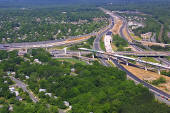 |
I-95/I-395/I-495
interchange construction, looking west. The Beltway runs from lower right
to upper center, and Shirley Highway runs from left to right.
The elevated ramp under construction in the
foreground is the B-610 bridge that will be the 2-lane express flyover
ramp (the I-95 southbound through route) from the Beltway Inner Loop (from
Wilson Bridge) to I-95 south.
In the center of the photo is the B-613 bridge under construction that will
be part of the relocated Beltway Outer Loop roadway. |
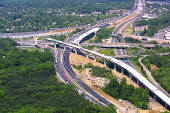 |
I-95/I-395/I-495 interchange construction,
looking west. The Beltway runs from lower right to upper right, and
Shirley Highway runs from left to right. The elevated ramp under
construction in the foreground is the B-610 bridge that will be the 2-lane
express flyover ramp (the I-95 southbound through route)
from
the Beltway Inner Loop (from Wilson Bridge) to I-95 south. In the center
of the photo is the B-613 bridge under construction that will be part of
the relocated Beltway Outer Loop roadway. |
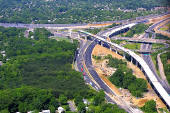 |
I-95/I-395/I-495 interchange construction,
looking west, similar vantage point to
previous photo.
The Beltway Outer Loop
roadway is being relocated in the interchange area, inboard of its original location
to the west of the interchange, to provide roadside space for wide high capacity ramps to
be built between the Outer Loop and Shirley Highway (I-95 and I-395),
without needing expensive right-of-way acquisition of many adjacent homes
and apartment buildings; and outboard of its original location to the east of the
interchange, to provide median space for the pair of elevated ramps with the
flyover bridges that connect the I-95 through traffic movements between
the I-95/I-495 Beltway and I-95 Shirley Highway. |
 |
I-95/I-395/I-495 interchange construction, looking
west along the Beltway.
Notice at the bottom of the photo, the temporary roadway for the Beltway Inner
Loop which passes under the southbound I-95 flyover bridge under construction. About 1/4 of a mile of the Inner Loop roadway is being reconstructed for the transition to the flyover, and the temporary roadway is carrying the traffic while
the reconstruction is underway.
Phase 4 of the SIIP involved these three major portions: constructing the
I-95 southbound roadway from the Capital Beltway to the VA-7900 Franconia-Springfield Parkway,
constructing a 4,870-foot-long flyover bridge for traffic heading west on
I-495 to I-95 south (the I-95 southbound through route), and widening the
Capital Beltway from I-395 east to VA-613 Van Dorn Street. Phase
4 was placed under construction in November 2000, and was completed
in October 2004 at a cost of $178.5 million.
Phases 4 and 5 of the SIIP included extensive construction
of sound barrier walls along the western, southern and eastern edges of
the interchange and approaches. |
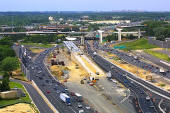 |
I-95/I-395/I-495 interchange construction, looking
north (toward Washington) from over Springfield, along Shirley Highway (I-95 and I-395). The Beltway
runs left to right in the top of the photo. Southbound mainline roadways and
ramps have been relocated to provide space to build the southern part of the
2-lane express flyover ramp
(the I-95 southbound through route) under construction from the Beltway
Inner Loop (from Wilson Bridge) to I-95 south.
Notice the sound barrier walls under
construction along the edge of the interchange. |
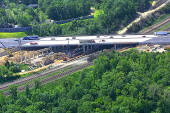 |
I-95/I-495 Beltway construction, widening the
east approach to the Springfield Interchange.
Looking south.
The bridge in the mainline of the
Beltway, passes over the 2-track CSXT railroad mainline (which carries freight trains,
Amtrak trains, and Virginia Railway Express commuter trains), and passes over
the 2-track WMATA Metrorail Franconia/Springfield Route (Blue Line trains). The pre-existing
pair of 4-lane bridges is being replaced by a pair of longer bridges that will
each have
7 lanes. The new Outer Loop bridge has been constructed, and Beltway
traffic is temporarily operating there with 4 lanes each way while the pre-existing
Inner Loop bridge is demolished and a new Inner Loop bridge is being built.
The replacement of these bridges was tedious due to railroad regulations
that limited construction to only a few hours per day. The new bridge
(B-635) has 4
spans, one over each railroad, and two to provide storm drainage.
The B-635 bridge is 507 feet long. |











